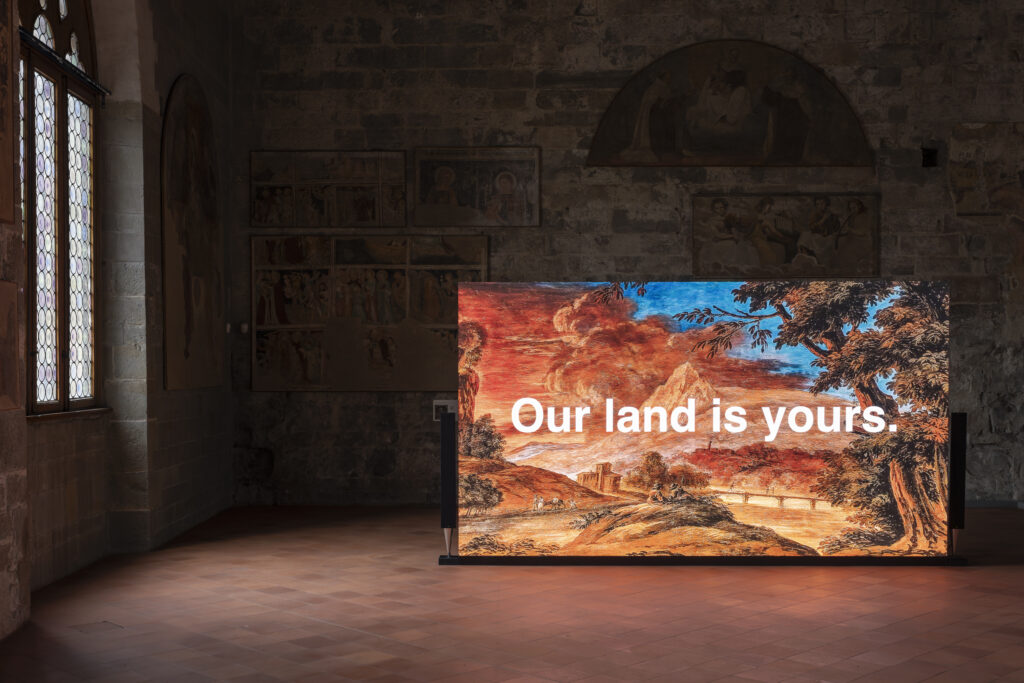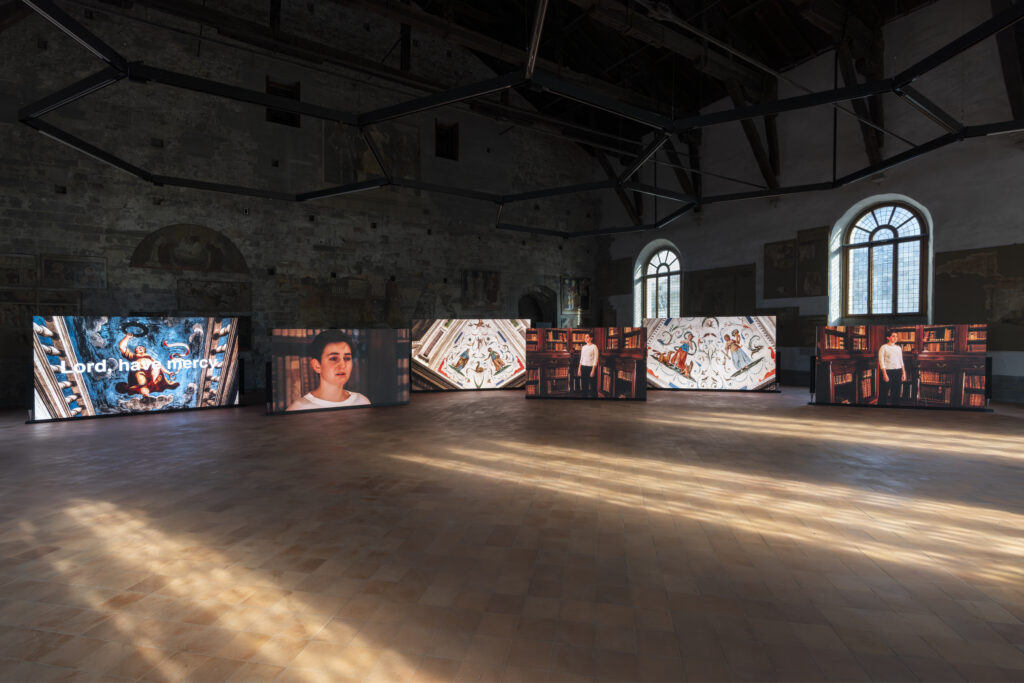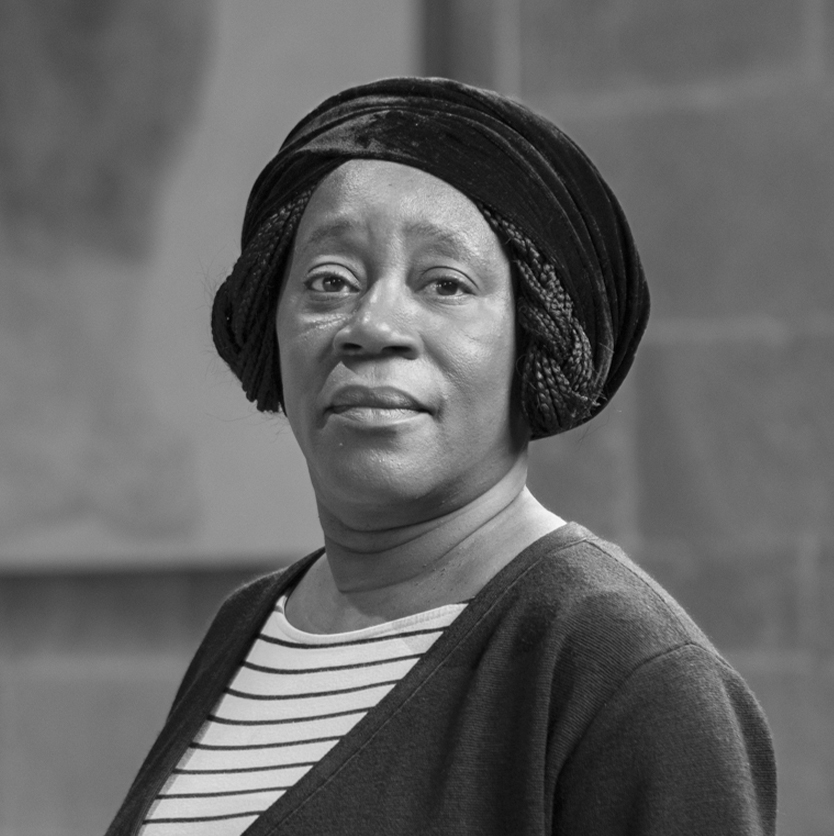On the occasion of the project Thinking Like a Mountain, GAMeC – Galleria d’Arte Moderna e Contemporanea di Bergamo returns to the prestigious Palazzo della Ragione venue, in the heart of the old town, with a new site-specific project conceived for the Sala delle Capriate by the English artist Sonia Boyce (London, 1962).
Since the late 1980s, the artist has addressed themes such as identity, social dynamics as well as racial and gender marginalization in an explicitly political manner. More recently, she has concentrated on experimenting with a relational practice that combines the aesthetic and political values of participation and collaboration, producing works that focus on history and “acoustic” memory, bound together by a love for music, sound and the voice, more closely linked to the notions of difference, intersectionality, and intercultural/transnational appropriation.
Through the development of multimedia projects—photographs, videos, and installations—Sonia Boyce documents the gestures of performative improvisation enacted by those involved in her works. In this perspective, collaborative processes negotiate the artist’s authorship and authority through dialogue and interaction with the community of reference, thus favoring collective creativity. Indeed, Boyce creates spaces that foster relationships based on improvisation, in which reflection on the interaction of the personalities of each finds its outcome in the construction of a community, without altering its nature.
The project for Palazzo della Ragione led the artist to approach the Bergamo area and its history with curiosity, and to focus her attention on traditional Italian folksongs that have long represented a powerful form of social commentary and a lyrical means of translating and sharing existential conditions.


Boyce embarked on a collaboration project with three students from the “Gaetano Donizetti” Higher Institute of Musical Studies in Bergamo, who were invited to perform and improvise popular songs in the heart of Bergamo’s “Città Alta.” In particular, in the preliminary phase of the project, the artist and the students noted how Bella Ciao—a key song in the country’s democratic history—has now become a symbol of global and transgenerational resistance.
This song provided the starting point for Boyce to undertake a major reflection on the meaning of music, its value over time and its ability to unite, but also to divide. Far from bearing ideological intentions, the song resonated spontaneously among passersby during the filming, amid the balconies of Piazza Vecchia, and it thus demonstrated how its strength lies in the very sense of community that itpromotes, and in the sense of dignity, peace, and hope that it invokes. The act of singing from balconies is an explicit reference to the lockdown period, during which people sang songs from their homes to support each other in a time of trouble. It is an action that inspired the artist, for whom singing itself represents a gesture of altruism and empathy, and folksongs in particular are a means of coming together and holding out a hand: “Singing spontaneously and publicly, in such moments of social anxiety, attests to the capacity of the human voice to transport our feelings and engender a form of social tenderness.” Today, just like in 2020, exchanges and encounters took place through sound and listening: an action that led to the sharing of an intersubjective space, to the display of collective attention, making a new system of common values vibrate through a chorus of voices.
This dialogue between Sonia Boyce and the students shows a great deal about the process that led to the staging of Benevolence, the environmental video installation produced for the exhibition at Palazzo della Ragione, and the various levels that can be traced both to the embryonic development of the project and to the visual rendering of this work, which originated from a performance made into a film.
The filming took place in Piazza Vecchia and in the adjacent Angelo Mai Civic Library, in particular in the Sala Tassiana, historically destined for the meetings of the Minor Council of the Municipality, and in the archive of the San Michele all’Arco book tower: a place of worship then deconsecrated in 1955. Environments that preserve and embrace a plurality of voices, of fragmentary memories, and ones that reveal their hybrid nature of being both private, reserved areas and at the same time spaces destined for the res publica, i.e. for norms and laws. It is the ornate vaults of the Sala Tassiana, with its seventeenth-century frescoes of grotesques and allegories of the virtues of good rulers by Pietro Baschenis, that inspired the title of the work. It is benevolence, as depicted by a woman about to breastfeed animals, which the artist chooses to place the emphasis on.
The exhibition brings together in six “visual monuments” occupying the Sala delle Capriate in Palazzo della Ragione—also an emblematic place of encounter between the public and private spheres—the work generated by the artist’s mediation of the video and photographic material filmed during the spontaneous performance in Piazza Vecchia and the sound improvisation of the singers in the library spaces. Benevolence explores how we experience music, sound, both collectively and intimately, through the juxtaposition of bodies and indoor and outdoor scenarios and settings, alternating between the various forms of sound interaction that inspired the singers.
Sound, by its porous nature, and the cultural and symbolic manifestation of music fostering social connections exert an influence on everyone’s capacity to participate. The Piazza effectively came alive as a meeting point, a collective place of enunciation through sound practices.
A further element of the artistic appropriation of the live performance documentation is provided by the practice of collage that has always characterized Boyce’s work, from the two-dimensional space of her early drawings to the editing and cutting of recent films, to the inclusion of frames with graphic patterns not unlike her well-known wallpapers, as in this new production. On the occasion of the exhibition, a new volume of the series of essays, published by Lenz and GAMeC, linked to the exhibition projects staged in the Palazzo della Ragione in Bergamo, will be published. The author will be the artist and sound theorist Brandon LaBelle. The exhibition is part of the project Thinking Like a Mountain: the cultural program promoted by GAMeC for the two-year period 2024–2025 that involves the territory of the Province of Bergamo with the aim of creating a pathway for sharing artistic experiences aimed at exploring the principles of sustainability and community.

Biographical Notes
Sonia Boyce DBE RA (b. London, 1962) is an interdisciplinary artist and academic working across film, drawing, photography, print, sound, and installation. In 2022 she presented FEELING HER WAY, a major commission for the British Pavilion at the 59th International Art Exhibition – La Biennale di Venezia for which she was awarded the Golden Lion for Best National Participation. Boyce came to prominence in the early 1980s as a key figure in the burgeoning British Black Arts Movement with figurative pastel drawings and photo collages that addressed issues of race and gender in Britain. Since the 1990s, however, Boyce has shifted significantly to embrace a social practice that invites improvisation, collaboration, movement, and sound with other people. Working across a range of media, Boyce’s practice today is focused on questions of artistic authorship and cultural difference. In 2016, Boyce was elected to the Royal Academy of Arts in London and in 2023, she was elected to the American Academy of Arts and Science in Boston. Since graduating in the early 1980s Boyce has consistently worked within the art school context. In 2014 she became a Professor at University of the Arts London, where she holds the inaugural Chair in Black Art & Design. A three year research project into Black Artists and Modernism culminated with a 2018 BBC documentary Whoever Heard of a Black Artist?, exploring the contribution of overlooked artists of African and Asian descent to the story of modern British art. In the King’s New Year Honours List of 2023, Boyce was awarded a Damehood.



